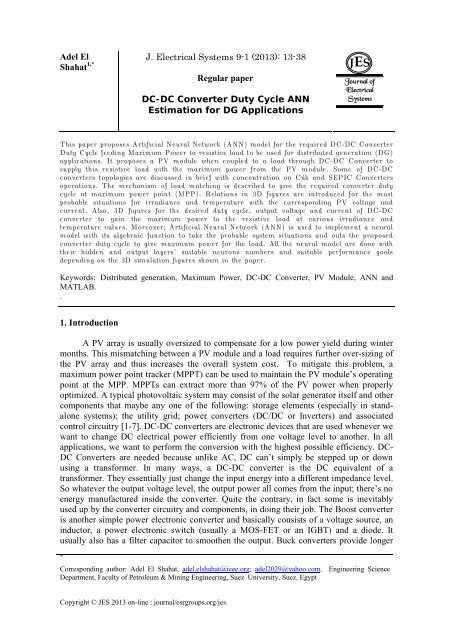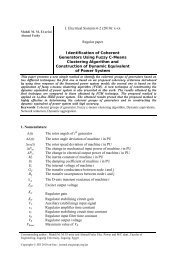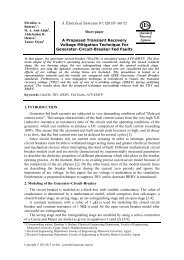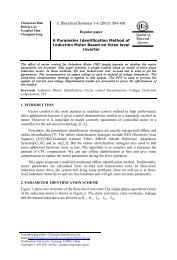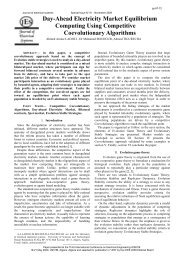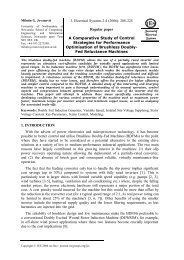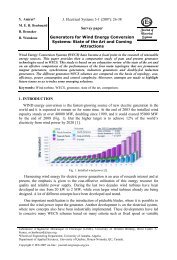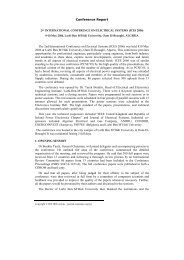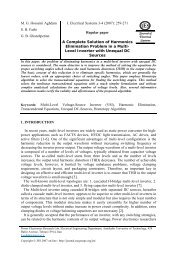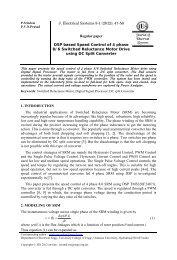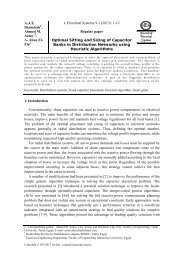DC-DC Converter Duty Cycle ANN Estimation for DG Applications
DC-DC Converter Duty Cycle ANN Estimation for DG Applications
DC-DC Converter Duty Cycle ANN Estimation for DG Applications
You also want an ePaper? Increase the reach of your titles
YUMPU automatically turns print PDFs into web optimized ePapers that Google loves.
J. Electrical Systems 9-1 (2013):13-38battery life <strong>for</strong> mobile systems that spend most of their time in “stand-by”. Buck regulatorsare often used as switch-mode power supplies <strong>for</strong> baseband digital core and the poweramplifier [8-13]. This paper proposes the part of <strong>DC</strong>-<strong>DC</strong> <strong>Converter</strong> coupled with resistiveload and supplying it with Maximum Power as shown in figure 1.Figure 1. Simple <strong>DG</strong> System with <strong>DC</strong>-<strong>DC</strong> <strong>Converter</strong> and Resistive Load2. Maximum Power Point <strong>for</strong> Resistive LoadWhen a PV module is directly coupled to a load, the PV module’s operating point willbe at the intersection of its I–V curve and the load line which is the I-V relationship of load.For example in figure 2, a resistive load has a straight line with a slope of 1/RLoad asshown in Figure 3. In other words, the impedance of load dictates the operating condition ofthe PV module. In general, this operating point is seldom at the PV module’s MPP, thus itis not producing the maximum power.A PV array is usually oversized to compensate <strong>for</strong> a low power yield during wintermonths. This mismatching between a PV module and a load requires further over-sizing ofthe PV array and thus increases the overall system cost. To mitigate this problem, amaximum power point tracker (MPPT) can be used to maintain the PV module’s operatingpoint at the MPP. MPPTs can extract more than 97% of the PV power when properlyoptimized. This section discusses the I-V characteristics of PV module and resistive load,matching between the two, and the use of <strong>DC</strong>-<strong>DC</strong> converters as a means of MPPT.Figure 2. PV module with a resistive load.14
J. Electrical Systems 9-1 (2013):13-38Figure 3. I-V curves of PV module and various resistive loads (1 kW/m 2 , 25C).3. <strong>DC</strong>-<strong>DC</strong> <strong>Converter</strong>The heart of MPPT hardware is a switch-mode <strong>DC</strong>-<strong>DC</strong> converter. It is widely used in<strong>DC</strong> power supplies and <strong>DC</strong> motor drives <strong>for</strong> the purpose of converting unregulated <strong>DC</strong>input into a controlled <strong>DC</strong> output at a desired voltage level [14]. MPPT uses the sameconverter <strong>for</strong> a different purpose: regulating the input voltage at the PV MPP and providingload-matching <strong>for</strong> the maximum power transfer. There are a number of different topologies<strong>for</strong> <strong>DC</strong>-<strong>DC</strong> converters. They are categorized into isolated or non-isolated topologies.The isolated topologies use a small-sized high-frequency electrical isolationtrans<strong>for</strong>mer which provides the benefits of <strong>DC</strong> isolation between input and output, and stepup or down of output voltage by changing the trans<strong>for</strong>mer turns ratio. They are very oftenused in switch-mode <strong>DC</strong> power supplies [15]. Popular topologies <strong>for</strong> a majority of theapplications are fly-back, half-bridge, and full-bridge. In PV applications, the grid-tiedsystems often use these types of topologies when electrical isolation is preferred <strong>for</strong> safetyreasons. Non-isolated topologies do not have isolation trans<strong>for</strong>mers.These topologies are further categorized into three types: step down (buck), step up(boost), and step up & down (buck -boost). The buck topology is used <strong>for</strong> voltage stepdown.In PV applications, the buck type converter is usually used <strong>for</strong> charging batteries andin LCB <strong>for</strong> water pumping systems. The boost topology is used <strong>for</strong> stepping up the voltage.The grid-tied systems use a boost type converter to step up the output voltage to the utilitylevel be<strong>for</strong>e the inverter stage. Then, there are topologies able to step up and down thevoltage such as: buck-boost, Cúk, and SEPIC (stands <strong>for</strong> Single Ended Primary Inductor<strong>Converter</strong>).For PV system with batteries, the MPP of commercial PV module is set above thecharging voltage of batteries <strong>for</strong> most combinations of irradiance and temperature. A buckconverter can operate at the MPP under most conditions, but it cannot do so when the MPPgoes below the battery charging voltage under a low-irradiance and high-temperaturecondition. Thus, the additional boost capability can slightly increase the overall efficiency[16].3.1 Cúk and SEPIC <strong>Converter</strong>sThe buck converter is the simplest topology and easiest to understand and design,however it exhibits the most severe destructive failure mode of all configurations [15].Another disadvantage is that the input current is discontinuous because of the switchlocated at the input, thus good input filter design is essential. Other topologies capable ofvoltage step-down are Cúk and SEPIC. Even though their voltage step-up function is15
J. Electrical Systems 9-1 (2013):13-38and L2 . The inductors are large enough, so assume that their currents are ripple free. Thus,the following relationship is established.Figure 6. Basic Cúk converter when the switch is ON.3.2.2 Mode 2: When SW turns OFF, the circuit becomes oneFigure 7. Basic Cúk converter when the switch is OFF.The capacitor ( C1 ) is getting charged by the input (V s ) through the inductor ( L1 ). The energystored in the inductor ( L2 ) is transfer to the load through the loop <strong>for</strong>med by D, C 2 , andR Load . Thus, the following relationship is established.For periodic operation, the average capacitor current is zero. Thus, from the equation (2)and (3):-I L2 . DT + I L1 . ( 1 – D ) T = 0 .....(5)I L1 / I L2 = D / ( 1 – D ).....(6)where: D is the duty cycle (0 < D < 1), and T is the switching period.Assuming that this is an ideal converter, the average power supplied by the source must bethe same as the average power absorbed by the load.P in = P out .....(7)V s . I L1 = V o . I L2 .....(8)I L1 / I L2 = V o / V s .....(9)Combining the equation (6) and (9), the following voltage transfer function is derived [14].V o / V s = D / ( 1 – D ).....(10)Its relationship to the duty cycle (D) is:If 0 < D < 0.5 the output is smaller than the input.If D = 0.5 the output is the same as the input.If 0.5 < D < 1 the output is larger than the input.3.3 Mechanism of Load MatchingAs described be<strong>for</strong>e, when PV is directly coupled with a load, the operating point ofPV is dictated by the load (or impedance to be specific). The impedance of load isdescribed as below.R Load = V o / I o .....(11)Where: V o is the output voltage, and Io is the output current.The optimal load <strong>for</strong> PV is described as:R opt = V MPP / I MPP .....(12)17
J. Electrical Systems 9-1 (2013):13-38Where: V MPP and I MPP are the voltage and current at the MPP respectively. When the valueof R Load matches with that of R opt , the maximum power transfer from PV to the load willoccur. These two are, however, independent and rarely matches in practice. The goal of theMPPT is to match the impedance of load to the optimal impedance of PV. The following isan example of load matching using an ideal (loss-less) Cúk converter. From the equation(10):V D 1 (13)DsV oFrom the equation (9)IIsoIIL1L2VVFrom the equation (13) and (14)IsI oos(14)D (15)1 DFrom the equation (13) and (15), the input impedance of the converter is:V (1 D)V (1 D) R(16)22soRin . .22Is D Io DLoadAs shown in figure 8, the impedance seem by PV is the input impedance of the converter(R in ). By changing the duty cycle (D), the value of R in can be matched with that of R opt .There<strong>for</strong>e, the impedance of the load can be anything as long as the duty cycle is adjustedaccordingly.+PVR in<strong>DC</strong>-<strong>DC</strong><strong>Converter</strong>R Load-Figure 8. The impedance seen by PV is R in that is adjustable by duty cycle (D).3.4 Maximum Power Point AlgorithmThe location of the MPP in the I–V plane is not known be<strong>for</strong>ehand and alwayschanges dynamically depending on irradiance and temperature. There<strong>for</strong>e, the MPP needsto be located by tracking algorithm, which is the heart of MPPT controller. The example ofresistive load matching is elaborated here to show how the output voltage and currentchange with varying irradiation and temperature. The maximum power transfer occurswhen the input impedance of converter matches with the optimal impedance of PV module,as described in the equation below.RVMPPin Ropt(17)IMPPThe required duty cycle (D) <strong>for</strong> the Cúk converter is:18
J. Electrical Systems 9-1 (2013):13-38D 11RRinLoadThe converter output voltage is:VoV s(18)D (19)1 DThe converter output voltage is:I D 1 (20)DoI sIt should be notified that, if the application requires a constant voltage, it must employbatteries to maintain the voltage constant. Also, of course, in reality <strong>DC</strong>-<strong>DC</strong> converter usedin MPPT is not 100% efficient. The efficiency gain from MPPT is large, but the systemneeds to take efficiency loss by <strong>DC</strong>-<strong>DC</strong> converter into account. There is also tradeoffbetween efficiency and the cost. It is necessary <strong>for</strong> PV system engineers to per<strong>for</strong>meconomic analysis of different systems and also necessary to seek other methods ofefficiency improvement such as the use of a sun tracker.4. PV Cell ModelThe use of equivalent electric circuits makes it possible to model characteristics of a PVcell. The method used here is implemented in MATLAB programs <strong>for</strong> simulations. Thesame modeling technique is also applicable <strong>for</strong> modeling a PV module. There are two keyparameters frequently used to characterize a PV cell. Shorting together the terminals of thecell, the photon generated current will follow out of the cell as a short-circuit current (Isc).Thus, Iph = Isc, when there is no connection to the PV cell (open-circuit), the photongenerated current is shunted internally by the intrinsic p-n junction diode. This gives theopen circuit voltage (Voc). The PV module or cell manufacturers usually provide the valuesof these parameters in their datasheets [35]. The ASE-300-<strong>DG</strong>F/50 is an industrial-gradesolar power module built to the highest standards. Extremely powerful and reliable, themodule delivers maximum per<strong>for</strong>mance in large systems that require higher voltages,including the most challenging conditions of military, utility and commercial installations.For superior per<strong>for</strong>mance, quality and peace of mind, the ASE-300-<strong>DG</strong>F/50 isrenowned as the first choice among those who recognize that not all solar modules arecreated equal [35]. The simplest model of a PV cell equivalent circuit consists of an idealcurrent source in parallel with an ideal diode. The current source represents the currentgenerated by photons (often denoted as Iph or IL), and its output is constant under constanttemperature and constant incident radiation of light. The PV panel is usually represented bythe single exponential model or the double exponential model. The single exponential modelis shown in fig. 9. The current is expressed in terms of voltage, current and temperature asshown in equation 21 [36].Figure 9. Single exponential model of a PV Cell.19
J. Electrical Systems 9-1 (2013):13-38Figure 10. Double exponential model of PV Cell.II q(V IR AkT) s Iph I0exp1q(V IR ) AkT V IR Rpq(V IR ) AkT ss Iph Is exp 1 Is exp112s V IR Rp(22)Where I ph : the photo generated current; I o : the dark saturation current; I s1 : saturation currentdue to diffusion; I s2 : is the saturation current due to recombination in the space chargelayer; I Rp : current flowing in the shunt resistance; R s : cell series resistance; R p : the cell(shunt) resistance; A: the diode quality factor; q: the electronic charge, 1.6 10 – 19 C; k:the Boltzmann’s constant, 1.3810 –23 J/K; and T: the ambient temperature, in Kelvin.Eq.21 and Eq.22 are both nonlinear. Furthermore, the parameters (I ph , I s1 , I s2 , R s , R sh and A)vary with temperature, irradiance and depend on manufacturing tolerance. Numericalmethods and curve fitting can be used to estimate [36], [37].There are three key operating points on the IV curve of a photovoltaic cell. They are theshort circuit point, maximum power point and the open circuit point. At the open – circuitpoint on the IV curve, V = V oc and I = 0. After substituting these values in the singleexponential equation (21) the equation can be obtained [36]. qVVs(21)ococ0 Iph Io exp AkT 1(23) RpAt the short – circuit point on the IV curve, I = I sc and V = 0. Similarly, using equation (1),we can obtain. qIscRs IscRsIsc Iph Io exp AkT 1(24) RpAt the maximum – power point of the IV curve, we have I = Impp and V = Vmpp. We canuse these values to obtain the following:q(Vmpp ImppRs) Vmpp ImppRsImpp Iph Ioexp 1(25) AkT RpThe power transferred to the load can be expressed asP = IV (26)We can estimate the diode quality factor as:Vmpp ImppRsoV(27)ocA VmppV I ocmppVTln(Isc Impp)ln(Isc ) RshoRoIsc(Voc/ Rso)AndR p = R sho (28)IoVocVoc ( Isc ). exp( )(29)R AVpT20
J. Electrical Systems 9-1 (2013):13-38RsAVTVoc Rso .exp( )(30)I AVoTRsIscRsIph Isc( 1 ) Io(exp 1)(31)RAVpTAs a very good approximation, the photon generated current, which is equal to I sc , isdirectly proportional to the irradiance, the intensity of illumination, to PV cell [38]. Thus, ifthe value, I sc , is known from the datasheet, under the standard test condition,G o =1000W/m 2 at the air mass (AM) = 1.5, then the photon generated current at any otherirradiance, G (W/m2), is given by:GI ( ) ISC Gsc G 0G0(32)It should be notified that, in a practical PV cell, there is a series of resistance in a currentpath through the semiconductor material, the metal grid, contacts, and current collectingbus [39]. These resistive losses are lumped together as a series resister (Rs). Its effectbecomes very conspicuous in a PV module that consists of many series-connected cells,and the value of resistance is multiplied by the number of cells. Shunt resistance is a lossassociated with a small leakage of current through a resistive path in parallel with theintrinsic device [39]. This can be represented by a parallel resister (Rp). Its effect is muchless conspicuous in a PV module compared to the series resistance so it may be ignored[39], [40]. The ideality factor denoted as A and takes the value between one and two (as toreach the nominated characteristics) [40].5. Photovoltaic Module ModelingA single PV cell produces an output voltage less than 1V, thus a number of PV cellsare connected in series to achieve a desired output voltage. When series-connected cells areplaced in a frame, it is called as a module. When the PV cells are wired together in series,the current output is the same as the single cell, but the voltage output is the sum of eachcell voltage. Also, multiple modules can be wired together in series or parallel to deliver thevoltage and current level needed. The group of modules is called an array. The panelconstruction provides protection <strong>for</strong> individual cells from water, dust etc, as the solar cellsare placed into an encapsulation of flat glass. Our case here depicts a typical connection of216 cells that are connected in series [35]. The strategy of modelling a PV module is nodifferent from modelling a PV cell. It uses the same PV cell model. The parameters are theall same, but only a voltage parameter (such as the open -circuit voltage) is different andmust be divided by the number of cells. An electric model with moderate complexity [17] isshown in figure 3, and provides fairly accurate results. The model consists of a currentsource (Isc), a diode (D), and a series resistance (Rs). The effect of parallel resistance (Rp)is very small in a single module, thus the model does not include it. To make a bettermodel, it also includes temperature effects on the short-circuit current (Isc) and the reversesaturation current of diode (Io). It uses a single diode with the diode ideality factor set toachieve the best I-V curve match.Figure 11. Equivalent circuit used in the simulations.21
J. Electrical Systems 9-1 (2013):13-38The equation (33) describes the current-voltage relationship of the PV cell.V IRsI Isc Io(exp( q ( )) 1)AkT(33)Where: I is the cell current ( the same as the module current); V is the cell voltage ={module voltage} /{No. of cells in series}; T is the cell temperature in Kelvin (K).First, calculate the short-circuit current (I sc ) at a given cell temperature (T):IscTIscTref[ 1 a ( T Tref)](34)Where: I sc at T ref is given in the datasheet (measured under irradiance of 1000W/m 2 ), T ref isthe reference temperature of PV cell in Kelvin (K), usually 298K (25 o C), a is thetemperature coefficient of I sc in percent change per degree temperature also given in thedatasheet.The short-circuit current (I sc ) is proportional to the intensity of irradiance, thus I sc at a givenirradiance (G) is introduced by Eq. 32. The reverse saturation current of diode (I o ) at thereference temperature ( T ref ) is given by the equation (35) with the diode ideality factoradded:IscI0qVoc(exp( ) 1)(35)AkTThe reverse saturation current ( I o ) is temperature dependant and the I o at a giventemperature (T) is calculated by the following equation [41].3T qE 1 1AgI0 I0( ) exp( ( ))T TrefTrefAk TrefTref(36)The diode ideality factor (A) is unknown and must be estimated. It takes a value betweenone and two; however, the more accurate value is estimated by curve fitting [41] also, it canbe estimated by try and error until accurate value achieved. E g is the Band gap energy (1.12V (Si); 1.42 (GaAs); 1.5 (CdTe); 1.75 (amorphous Si)). The series resistance ( R s ) of the PVmodule has a large impact on the slope of the I-V curve near the open-circuit voltage (V oc ),hence the value of R s is calculated by evaluating the slope dI/dV of the I-V curve at the V oc[41]. The equation <strong>for</strong> R s is derived by differentiating the I-V equation and then rearrangingit in terms of R s as introduced in equation (37).dVAkT / qRs VocdIqVocI exp( )(37)0AkTdVWhere: is the slope of the I-V curve at the VV oc (using the I-V curve in the datasheetdIocthen divide it by the number of cells in series); V oc is the open-circuit voltage of cell(Dividing V oc in the datasheet by the number of cells in series).Finally, the equation of I-V characteristics is solved using the Newton’s method <strong>for</strong> rapidconvergence of the answer, because the solution of current is recursive by inclusion of aseries resistance in the model [41]. The Newton’s method is described as:f ( xn)xn 1 xnf ' ( xn)(38)Where: f’(x) is the derivative of the function, f(x) = 0, x n is a present value, and x n+1 is anext value.22
J. Electrical Systems 9-1 (2013):13-38V IRsf ( I ) Isc I Io(exp( q()) 1) 0AkT(39)By using the above equations the following output current (I) is computed iteratively.V InRsIsc In Io(exp( q()) 1)IAkTn1 InqRsV InRs 1 Io( ) exp( q())(40)AkTAkTThe figures of I-V characteristics at various module temperatures are simulated with theMATLAB model <strong>for</strong> our PV module are shown. Also, the P-V relations at various moduletemperatures are presented. All of these are done at various irradiance values areintroduced.6. Simulation ResultsThe calculation results are presented by two ways: one in 2D figures, and other withthe use of 3D figures. These results are based on PV module data and the MATLABsimulation model which implemented in previous section. Relations between all possiblepredicted resistances values <strong>for</strong> all the entire I-V curves with the desired optimumresistance values are presented at the first from figure 12 to figure 15. We want theconverter to make the load matching at the points of intersections between the curves <strong>for</strong>the most probable global values of the load resistances and the straight lines of optimumload values in order to transfer the required maximum power <strong>for</strong> the resistive load.Resistive Load & Optimum Values (Ohm)403530252015105T = 0 CT = 25CT = 50CT = 75C00 10 20 30 40 50 60 70Module Voltage (Volt)Figure 12. Resistive load & Optimum resistance values with Voltage at 1 kW/m 2 IrradianceResistive Load & Optimum Values (Ohm)60504030201000 10 20 30 40 50 60 70Module Voltage (Volt)Figure 13. Resistive load & Optimum resistance with Voltage at 0.75 kW/m 2 Irradiance23
J. Electrical Systems 9-1 (2013):13-38Resistive Load & Optimum Values (Ohm)60504030201000 10 20 30 40 50 60 70Module Voltage (Volt)Figure 14. Resistive load and Optimum resistance with Voltage at 0.50 kW/m 2 IrradianceResistive Load & Optimum Values (Ohm)807060504030201000 10 20 30 40 50 60Module Voltage (Volt)Figure 15. Resistive load and Optimum resistance with Voltage at 0.25 kW/m 2 IrradianceAfter that, a set of 3 D figures (from fig. 1 6 to fig. 23) are proposed to cover the mostprobable situations at various irradiance, various temperature with the current, and thevoltage of the PV module. These surface faces relations will be considered later as the inputlearning or training data <strong>for</strong> the proposed neural network model. All these figures are basedon the MATLAB PV module modeling introduced be<strong>for</strong>e.2Irradiance (kW/m2)1.510.5100 0806060404020200 0Module Voltage (V)Temperature (C)Figure 16. Voltage & Temp.& (1KW/m 2 ) Irradiance802Irradiance (kW/m2)1.510.5086460402200 0Module Current (A)Temperature (C)Figure 17. Current & Temp.& (1KW/m 2 ) Irradiance8024
J. Electrical Systems 9-1 (2013):13-38Irradiance (kW/m2)21.510.5100 0806060404020200 0Module Voltage (V)Temperature (C)Figure 18. Voltage & Temperature& (0.75KW/m 2 )80Irradiance (kW/m2)21.510.50-0.56460240200 0Module Current (A)Temperature (C)Figure 19. Current & Temperature&(0.75KW/m 2 )80Irradiance (kW/m2)1.510.5100 0806060404020200 0Module Voltage (V)Temperature (C)Figure 20. Voltage & Temperature&(0.50KW/m 2 )801.5Irradiance (kW/m2)10.5043260401200 0Module Current (A)Temperature (C)Figure 21. Current & Temperature&(0.50KW/m 2 )8025
J. Electrical Systems 9-1 (2013):13-381.5Irradiance (kW/m2)10.5100 08060404020200 0Module Voltage (V)Temperature (C)Figure 22. Voltage & Temperature&(0.25KW/m 2 )60801.5Irradiance (kW/m2)10.5021.51Module Current (A)0.5002040Temperature (C)6080Figure 23. Current & Temperature&(0.25KW/m 2 )Finally, the relations of converter duty cycle, converter output voltage, and converter outputcurrent values to transfer the maximum power from the PV module to various values ofresistive loads. The converter duty cycle values from these relations are taken as target oroutput values. These relations are presented with variable values of temperature andirradiance in figures from 24 to 35.2Irradiance (kW/m2)1.510.5010.80.6<strong>Duty</strong> <strong>Cycle</strong>0.40.2001020304050Temperature (C)607080Figure 24. <strong>Converter</strong> <strong>Duty</strong> <strong>Cycle</strong> <strong>for</strong> max. power with Temperature and 1 kW/m 2 Irradiance26
J. Electrical Systems 9-1 (2013):13-38Irradiance (kW/m2)21.510.5120 010080010203040506070806040200Coverter Output Voltage (Volt)Temperature (C)Figure 25. <strong>Converter</strong> Output Voltage <strong>for</strong> max. power with Temp. and 1 kW/m 2 Irradiance2Irradiance (kW/m2)1.510.540 03020<strong>Converter</strong> Output Current (Amp.)10001020304050Temperature (C)607080Figure 26. <strong>Converter</strong> Output Current <strong>for</strong> max. power with Temp. and 1 kW/m 2 Irradiance2Irradiance (kW/m2)1.510.5010.80.6<strong>Duty</strong> <strong>Cycle</strong>0.40.2001020304050Temperature (C)607080Figure 27. <strong>Converter</strong> <strong>Duty</strong> <strong>Cycle</strong> <strong>for</strong> max. power with Temp. and 0.75 kW/m 2 Irradiance2Irradiance (kW/m2)1.510.5120 010080604020001020304050607080<strong>Converter</strong> Output Voltage (Volt)Temperature (C)Figure 28. <strong>Converter</strong> Output Voltage <strong>for</strong> max. power with Temp. and 0.75 kW/m 2 Irradiance27
J. Electrical Systems 9-1 (2013):13-382Irradiance (kW/m2)1.510.530 0252015<strong>Converter</strong> Output Current (Amp.)105001020304050Temperature (C)607080Figure 29. <strong>Converter</strong> Output Current <strong>for</strong> max. power with Temp. and 0.75 kW/m 2 Irradiance1.5Irradiance (kW/m2)10.5010.80.6<strong>Duty</strong> <strong>Cycle</strong>0.40.2001020304050Temperature (C)607080Figure 30. <strong>Converter</strong> <strong>Duty</strong> <strong>Cycle</strong> <strong>for</strong> max. power with Temp. and 0.50 kW/m 2 Irradiance1.5Irradiance (kW/m2)10.50150100<strong>Converter</strong> Output Voltage (Volt)50001020304050Temperature (C)607080Figure 31. <strong>Converter</strong> Output Voltage <strong>for</strong> max. power & Temp. and 0.50 kW/m 2 Irradiance1.5Irradiance (kW/m2)10.520 01510<strong>Converter</strong> Output Current (Amp.)5001020503040Temperature (C)607080Figure 32. <strong>Converter</strong> Output Current <strong>for</strong> max. power with Temp. and 0.50 kW/m 2 Irradiance28
J. Electrical Systems 9-1 (2013):13-381.5Irradiance (kW/m2)10.5010.80.6<strong>Duty</strong> <strong>Cycle</strong>0.40.2001020405030Temperature (C)607080Figure 33. <strong>Converter</strong> <strong>Duty</strong> <strong>Cycle</strong> <strong>for</strong> maximum power & Temp. and 0.25 kW/m 2 Irradiance1.5Irradiance (kW/m2)10.5150 0100<strong>Converter</strong> Output Voltage (Volt)50001020304050Temperature (C)607080Figure 34. <strong>Converter</strong> Output Voltage <strong>for</strong> max. power with Temp. and 0.25 kW/m 2 Irradiance1.5Irradiance (kW/m2)10.510 0864<strong>Converter</strong> Output Current (Amp.)2001020503040Temperature (C)607080Figure 35. <strong>Converter</strong> Output Current <strong>for</strong> max. power with Temp. and 0.25 kW/m 2 Irradiance7. Artificial Neural Networks (<strong>ANN</strong>s) TechniqueAn <strong>ANN</strong> consists of very simple and highly interconnected processors called neurons.The neurons are connected to each other by weighted links over which signals can pass.Each neuron receives multiple inputs from other neurons in proportion to their connectionweights and generates a single output which may propagate to several other neurons [17].Among the various kinds of <strong>ANN</strong>s that exist, the Back-propagation learning algorithm hasbecome the most popular used method in engineering application. It can be applied to anyfeed-<strong>for</strong>ward network with differentiable activation functions [18], and it is the type ofnetwork used in this paper.7.1 Fundamentals of Neural NetworkThe <strong>ANN</strong> modeling is carried out in two steps; the first step is to train the network,whereas the second step is to test the network with data, which were not used <strong>for</strong> training. It29
J. Electrical Systems 9-1 (2013):13-38is important that all the in<strong>for</strong>mation the network needs to learn is supplied to the network asa data set. When each pattern is read, the network uses the input data to produce an output,which is then compared to the training pattern. If there is a difference, the connectionweights are altered in such a direction that the error is decreased. After the network has runthrough all the input patterns, if the error is still greater than the maximum desiredtolerance, the <strong>ANN</strong> runs through all the input patterns repeatedly until all the errors arewithin the required tolerance [19], [20].7.2 Data Collection, Analysis and ProcessingQuality, availability, reliability, repeatability, and relevance of the data used todevelop and run the system is critical to its success. Data processing starts from the datacollections and analysis followed by pre-processing and then feeds to the neural network.7.3 Network Structure DesignThough theoretically there exists a network that can simulate a problem to anyaccuracy, there is no easy way to find it. To define an exact network architecture such ashow many hidden layers should be used, how many units should there be within a hiddenlayer <strong>for</strong> a certain problem is a painful job.7.3.1 Number of Hidden LayersBecause networks with two hidden layers can represent functions with any kind ofshapes, there is no theoretical reason to use networks with more than two hidden layers. Ingeneral, it is strongly recommended that one hidden layer be the first choice <strong>for</strong> any feed<strong>for</strong>wardnetwork design [17-20].7.3.2 Number of Hidden Units (node)Another important issue in designing a network is how many units to place in eachlayer. Using too few units can fail to detect the signals fully in a complicated data set,leading to under fitting. Using too many units will increase the training time, perhaps somuch that it becomes impossible to train it adequately in a reasonable period of time. Thebest number of hidden units depends on many factors – the numbers of input and outputunits, the number of training cases, the amount of noise in the targets, the complexity of theerror function, the network architecture, and the training algorithm. The best approach tofind the optimal number of hidden units is trial and error.7.3.3 Initializing Back-Propagation feed-<strong>for</strong>ward networkBack-propagation is the most commonly used method <strong>for</strong> training multi-layer feed<strong>for</strong>wardnetworks. For most networks, the learning process is based on a suitable errorfunction, which is then minimized with respect to the weights and bias. The algorithm <strong>for</strong>evaluating the derivative of the error function is known as back-propagation, because itpropagates the errors backward through the network.8. <strong>ANN</strong> Required <strong>Duty</strong> <strong>Cycle</strong> Model with its regression functionAll the neural models in this section use the previous technique which used andverified be<strong>for</strong>e like in [22-34] <strong>for</strong> the author in the field of green energy. First, <strong>ANN</strong> PVmodule model is presented with its regression function which is verified be<strong>for</strong>e by theauthor [42]. This model uses the previous 3D graphs illustrated be<strong>for</strong>e as training orlearning data <strong>for</strong> input and desired target. The inputs in this model are the Irradiance and30
J. Electrical Systems 9-1 (2013):13-38Temperature; the outputs are: Module Voltage, Current, and Power. This model with itshidden and output layers’ suitable neurons numbers is depicted in figure 36. Also, thegeneral neural network, and training state are presented in figures 37, and 38 respectively.This model would be used in some cases to help in predicting the required duty cycle as itwill be seen.Figure 36. <strong>ANN</strong> PV Cell Module ModelFigure 37. Neural NetworkFigure 38. Training StateThe normalized inputs G n : (Normalized Irradiance); T n : ( Normalized Temperature) are :G n (G - 0.6250)/ (0.2797)(41)T (T - 7000279683)n(42)Equations (41) and (42) present the normalized inputs <strong>for</strong> irradiance and temperature, alsothe following equations lead to the required derived outputs equations.E1- 0.3884G 0.8968TF11/(1exp (- E1))E2 10.8336G 0.1120TF2 1/(1exp (- E2))E3 - 0.3773G 9.6071TF3 1/(1exp (- E3))nnnnnn 2.8411 4.7062 7.2495(43)(44)(45)31
J. Electrical Systems 9-1 (2013):13-38E4 - 0.0696G 9.4705TF4 1/(1exp (- E4))E5 6.3252G 0.3523TF5 1/(1exp (- E5))E6 - 0.1062G 3.4660TF6 1/(1exp (- E6))E7 0.1802G 4.0327TF7 1/(1exp (- E7))E8 11.6503G1.1094TF8 1/(1exp (- E8))E9 0.2372G 0.8735TF9 1/(1exp (- E9))nnnnnnnnnn 5.0369 4.6963nn 8.7149 3.715711.1433 0.7613(46)(47)(48)(49)(50)(51)The normalized outputs are:V n = 0.0466 F1 + 0.0080 F2 + 0.0661 F3 – 0.2311 F4 – 0.0071 F5 + 2.5608 F6 + 0.0771F7 + 0.0091 F8 - 0.0217 F9 - 2.7656 (52)I n = 6.2907 F1 + 1.5501 F2 + 0.2881 F3 + 1.8330 F4 - 1.1986 F5 - 0.6123 F6 -1.2526 F7 + 1.6547 F8 - 2.6831 F9 - 6.1682 (53)P n = 7.2249 F1 + 1.7820 F2 + 1.0262 F3 + 5.1377 F4 - 1.3507 F5 - 0.9574 F6 +3.4515 F7 + 1.8830 F8 - 6.9036 F9 - 7.3615 (54)The un- normalized out putsV = 25.2226 V n + 42.6563 (55)I = 2.1788 I n + 2.3181 (56)P = 57.5303 P n + 81.4030 (57)Then, the first <strong>ANN</strong> model <strong>for</strong> predicting the required duty cycle <strong>for</strong> maximum powersupply is presented as follow. The inputs in this model are the Irradiance and Temperature;the output is the required duty cycle to drive the <strong>DC</strong>/<strong>DC</strong> converter at maximum powertransfer <strong>for</strong> the resistive load matching. This model with its hidden and output layers’suitable neurons numbers is well depicted in figure 39. Also, the general neural network,and training state are presented in figures 37, and 40 respectively.Figure 39. <strong>Duty</strong> cycle <strong>ANN</strong> Model32
J. Electrical Systems 9-1 (2013):13-38Figure 40. Training StateThe algebraic equation of this neural model is deduced as the following:E1- 0.3590G 0.3814T 0.3804F11/(1exp (- E1))E2 - 0.0141G 6.4507TF2 1/(1exp (- E2))E3 - 0.0351G 0.9089TF3 1/(1exp (- E3))E4 8.5133G 4.3558TF4 1/(1exp (- E4))E5 5.6139G 0.2623TF5 1/(1exp (- E5))E6 - 9.6390G 4.2841TF6 1/(1exp (- E6))nnnnnnnnnnn 3.8184 0.9329 2.4202 3.4972n 4.0081(58)(59)(60)(61)(62)(63)The normalized outputs are:D n = 0.6425 F1 - 0.3052 F2 - 1.8018 F3 - 0.0027 F4 - 0.1021 F5 - 0.0181 F6 +0.4733 (64)The un- normalized out putsD = 0.3087 D n + 0.6542 (65)After that, the second <strong>ANN</strong> model <strong>for</strong> predicting the required duty cycle <strong>for</strong> maximumpower supply is presented as follow. The inputs in this model are the module voltage andmodule current; the output is the required duty cycle to drive the <strong>DC</strong>/<strong>DC</strong> converter atmaximum power transfer <strong>for</strong> the resistive load matching. This model with its hidden andoutput layers’ suitable neurons numbers is well depicted in figure 41. Also, the generalneural network, and training state are presented in figures 37, and 42 respectively.Figure 41. <strong>Duty</strong> cycle <strong>ANN</strong> Model33
J. Electrical Systems 9-1 (2013):13-38Figure 42. Training StateThe algebraic equation of this neural model is deduced as the following:The normalized inputs V n : (Normalized Voltage); I n : ( Normalized Current) are as follow:V n (V- 42.6563)/ (25.2226)(66)I (I - 2.178823181)n(67)Equations (66) and (67) present the normalized inputs <strong>for</strong> irradiance and temperature, alsothe following equations lead to the required derived outputs equations.E10.1708V 0.0757 IF11/(1exp (- E1))E2 - 0.3229 V 6.6072 IF2 1/(1exp (- E2))E3 20.3367 V 0.0538IF3 1/(1exp (- E3))E4 - 4.3491V 0.2479IF4 1/(1exp (- E4))nnnnn 3.5535nnn 5.977738.81856.2840The normalized outputs are:D n = 39.5715 F1 + 2.7944 F2 + 56.3549 F3 - 0.9435 F4 - 57.9687 (72)The un- normalized out putsD = 0.3087 D n + 0.6542 (73)Finally, the third <strong>ANN</strong> model <strong>for</strong> predicting the required duty cycle <strong>for</strong> maximum powersupply is presented as follow. The inputs in this model are the irradiance, temperature,module voltage and module current; the output is the required duty cycle to drive the<strong>DC</strong>/<strong>DC</strong> converter at maximum power transfer <strong>for</strong> the resistive load matching. This modelwith its hidden and output layers’ suitable neurons numbers is well depicted in figure 43.Also, the general neural network, and training state are presented in figures 37, and 44respectively.(68)(69)(70)(71)Figure 43. <strong>Duty</strong> cycle <strong>ANN</strong> Model34
J. Electrical Systems 9-1 (2013):13-38Figure 44. Training StateThe algebraic equation of this neural model is deduced as the following:The normalized inputs G n : (Normalized Irradiance); T n : ( Normalized Temperature); V n :(Normalized Voltage); I n : ( Normalized Current) are as follow:G n (G - 0.6250)/ (0.2797)(74)T (T - 7000279683)n(75)V n (V- 42.6563)/ (25.2226)(76)I (I - 2.178823181)n(77)Equations (74), (75), (76) and (77) present the normalized inputs <strong>for</strong> irradiance,temperature, voltage, and current. The following equations lead to the required derivedoutputs equations.E10.5936G- 0.0564TF11/(1exp (- E1))E2 0.5943G - 0.0479TF2 1/(1exp (- E2))E3 -1.5461G 9.1499TF3 1/(1exp (- E3))nnnnnn1.2431V1.2037 Vnn12.5644V- 0.6579 I- 0.6658Innn 4.8012 In4.84875.5987- 7.1509The normalized outputs are:D n = 1.0e+003 * (- 0.5322 F1 + 1.1651 F2 + 0.0014 F3) - 633.1165 (81)The un- normalized out putsD = 0.3087 D n + 0.6542 (82)9. ConclusionThis paper introduces Cúk <strong>DC</strong>-<strong>DC</strong> converter coupled to resistive load by maximumpower from PV module. Relations which govern the process of load matching are discussedto give the required converter duty cycle at maximum power point (MPP). The simulationresults are introduced by two ways first by 2D figures <strong>for</strong> the optimum resistive load valuesand <strong>for</strong> the predicted whole probable range of resistive loads to give a point of view aboutthe intersection between them i.e. point of MPP. Second, the rest of the results are welldepicted in the <strong>for</strong>m of 3D figures <strong>for</strong> the PV module relations I-V with the various valuesof irradiance and temperature based on PV module data and the implemented MATLAB(78)(79)(80)35
J. Electrical Systems 9-1 (2013):13-38simulation model. Then, the relations of converter duty cycle, converter output voltage, andconverter output current values to transfer the maximum power from the PV module tovarious values of resistive loads with variable values of temperature and irradiance. Theneural network has the ability to deal with previous relations as surface or mapping face,due to this technique ability <strong>for</strong> interpolation between points with each other and alsocurves. This neural network unit is implemented, using the back propagation (BP) learningalgorithm due to its benefits to have the ability to predict values in – between learningvalues, also make interpolation between learning curves data. This is done with suitablenumber of network layers and neurons at minimum error and precise manner. The <strong>ANN</strong>regression function <strong>for</strong> each unit is introduced to be used directly without operating theneural model each times. First, <strong>ANN</strong> PV module model is presented with its regressionfunction, its inputs are the Irradiance and Temperature; the outputs are: Module Voltage,Current, and Power. Then, the first <strong>ANN</strong> model <strong>for</strong> predicting the required duty cycle <strong>for</strong>maximum power supply is introduced with its regression function, its inputs the Irradianceand Temperature; the output is the required duty cycle to drive the <strong>DC</strong>/<strong>DC</strong> converter atmaximum power transfer <strong>for</strong> the resistive load matching. After that, the second <strong>ANN</strong> model<strong>for</strong> predicting the required duty cycle <strong>for</strong> maximum power supply is illustrated with itsregression function, its inputs are the module voltage and module current; the output is therequired duty cycle to drive the <strong>DC</strong>/<strong>DC</strong> converter at maximum power transfer <strong>for</strong> theresistive load matching. Finally, the third <strong>ANN</strong> model <strong>for</strong> predicting the required duty cycle<strong>for</strong> maximum power supply is proposed with its regression function, its inputs are theirradiance, temperature, module voltage and module current; the output is the required dutycycle to drive the <strong>DC</strong>/<strong>DC</strong> converter at maximum power transfer <strong>for</strong> the resistive loadmatching.References[1] T. Markvart and L. Castaner, Practical Handbook of Photovoltaics, Fundamentals and <strong>Applications</strong>.Elsevier, 2003.[2] K. Hussein, I. Muta, T. Hoshino, and M. Osakada, “Maximum photovoltaic power tracking: an algorithm <strong>for</strong>rapidly changing atmospheric conditions,” Generation, Transmission and Distribution, IEE Proceedings-,vol. 142, pp. 59–64, Jan 1995.[3] Hohm, D. P. & M. E. Ropp “Comparative Study of Maximum Power Point Tracking Algorithms” Progressin Photovoltaics: Research and <strong>Applications</strong> November 2002, page 47-62[4] G.Walker, \Evaluating mppt converter topologies using a matlab pv model," Journal of Electrical andElectronics Engineering, vol. 21, no. 1, p. 4956, 2001.[5] Adel El Shahat, “Maximum Power Point Genetic Identification Function <strong>for</strong> Photovoltaic System”,International Journal of Research and Reviews in Applied Sciences, June 2010, (In Press).[6] Min Dai, M.N. Marwali, Jin-Woo Jung, A. Keyhani, "A Three-Phase Four-Wire Inverter Control Technique<strong>for</strong> a Single Distributed Generation Unit in Island Mode", IEEE Transactions on Power Electronics, Vol. 23,Issue 1, Jan. 2008, pp. 322 – 331[7] Jin-Woo Jung and Ali Keyhani, "Control of a Fuel Cell Based Z-Source <strong>Converter</strong>", IEEE Transactions onEnergy Conversion, Volume 22, No. 2, June 2007, pp. 467-476[8] Michael D. Mulligan, Bill Broach, and Thomas H. Lee, “A Constant-Frequency Method <strong>for</strong> ImprovingLight-Load Efficiency in Synchronous Buck <strong>Converter</strong>s”, Power Electronics Letters, IEEE Volume 3, Issue1, March 2005 Page(s): 24 - 29[9] R.D. Middlebrook and S. Cuk, "A General Unified Approach To Modelling Switching-<strong>Converter</strong> PowerStages", IEEE Power Electronics Specialists Conference, 1976 Record, pp 18-34.[10] Mikkel C. W. Høyerby, Michael A.E. Anderssen, “Envelope Tracking Power Supply with fully controlled4th order Output Filter”, Applied Power Electronics Conference and Exposition, 2006. Twenty-First AnnualIEEE, 19-23 March 2006 Page(s): 8 pp. -[11] Chin Chang, “Robust Control of <strong>DC</strong>-<strong>DC</strong> <strong>Converter</strong>s: The Buck <strong>Converter</strong>”, Power Electronics SpecialistsConference, 1995. 26th Annual IEEE Volume 2, Issue , 18-22 Jun 1995 Page(s):1094 - 1097 vol.2[12] Mika Sippola and Raimo Sepponen, “<strong>DC</strong>/<strong>DC</strong> <strong>Converter</strong> technology <strong>for</strong> distributed telecom andmicroprocessor power systems – a literature review”, Helsinki University of Technology AppliedElectronics Laboratory, Series E: Electronic Publications E 3, 200236
J. Electrical Systems 9-1 (2013):13-38[13] Chang, C., “Mixed Voltage/Current Mode Control of PWM Synchronous Buck <strong>Converter</strong>”, PowerElectronics and Motion Control Conference, 2004. IPEMC 2004. The 4th International, Publication Date:14-16 Aug. 2004, Volume: 3, On page(s): 1136- 1139 Vol.3.[14] Mohan, Undeland, Robbins Power Electronics – <strong>Converter</strong>s, <strong>Applications</strong>, and Design 3rd Edition JohnWiley & Sons Ltd, 2003[15] Rashid, Muhammad H. Power Electronics - Circuits, Devices, and <strong>Applications</strong> 3rd Edition PearsonEducation, 2004[16] Walker, Geoff R. “Evaluating MPPT converter topologies using a MATLAB PV model” AustralasianUniversities Power Engineering Conference, AUPEC ‘00,Brisbane, 2000[17] TT Chow, Zhang GQ, Lin Z, Song CL.: Global optimization of absorption chiller system by geneticalgorithm and neural network. Energy Buildings 2002;34:103–9.[18] SA Kalogirou “<strong>Applications</strong> of artificial neural networks in energy systems: a review,” Energy ConversManage 1999; 40:1073–87.[19] SA. Kalogirou “<strong>Applications</strong> of artificial neural networks <strong>for</strong> energy systems,” Appl Energy 2000; 67:17–35.[20] SA. Kalogirou “Long-term per<strong>for</strong>mance prediction of <strong>for</strong>ced circulation solar domestic water heatingSystems using artificial neural networks,” Appl Energy 2000; 66:63–74.[21] Arzu Sencan, Kemal A.Yakut, Soteris A.Kalogirou “ Thermodynamic analysis of absorption systems usingartificial neural network,” Renewable Energy, Volume 31, issue 1, Jan. 2006, pages 29 – 43.[22] A. El Shahat, and H. El Shewy, “PM Synchronous Motor Control Strategies with Their Neural NetworkRegression Functions”, Journal of Electrical Systems, Vol. 5, Issue 4, Dec. 2009.[23] Adel El Shahat and Hamed El Shewy, “High Fundamental Frequency PM Synchronous Motor DesignNeural Regression Function”, Journal of Electrical Engineering, Vol. 10 / 2010 – Edition 1, Article 10.1.14.[24] Adel El Shahat, and Hamed El Shewy, “High Speed Synchronous Motor Basic Sizing Neural Function <strong>for</strong>Renewable Energy <strong>Applications</strong>”, M<strong>DG</strong>EN05, The International Conference on Millennium DevelopmentGoals (M<strong>DG</strong>): Role of ICT and other technologies December 27 – 29, 2009 in Chennai, India.[25] Adel El Shahat, and Hamed El Shewy, “High Speed PM Synchronous Motor Basic Sizing NeuralRegression Function <strong>for</strong> Renewable Energy <strong>Applications</strong>”, Paper ID: X304, Accepted in 2nd InternationalConference on Computer and Electrical Engineering (ICCEE 2009); Dubai, UAE, December 28 - 30, 2009.[26] A. El Shahat, “Generating Basic Sizing Design Regression Neural Function <strong>for</strong> HSPMSM in Aircraft” EP-127, 13th International Conference on Aerospace Science & Aviation Technology, May 26 – 28, 2009,ASAT 2009 – Military Technical College, Cairo, Egypt.[27] Adel El Shahat, and Hamed El Shewy, “High Speed PM Synchronous Motor Basic Sizing NeuralRegression Function <strong>for</strong> Renewable Energy <strong>Applications</strong>”, Paper ID: X304, Accepted in 2nd InternationalConference on Computer and Electrical Engineering (ICCEE 2009); Dubai, UAE, December 28 - 30, 2009.[28] El Shahat, A and El Shewy, H, “Neural Unit <strong>for</strong> PM Synchronous Machine Per<strong>for</strong>mance Improvement used<strong>for</strong> Renewable Energy”, Ref: 93, The Third Ain Shams University International Conference onEnvironmental Engineering (Ascee- 3 ), April 14-16 2009, Cairo, Egypt.[29] A. El Shahat, H. El Shewy, “Neural Unit <strong>for</strong> PM Synchronous Machine Per<strong>for</strong>mance Improvement used <strong>for</strong>Renewable Energy”, Paper Ref.: 910, Global Conference on Renewable and Energy Efficiency <strong>for</strong> DesertRegions (GCREEDER2009), Amman, Jordan.[30] S. Nafey, A. El Shahat and M. A. Sharaf, “A Neural Model <strong>for</strong> Flat Plate Collector”, EGY- 38, 6thInternational Conference on Role of Engineering towards a Better Environment, RETBE’06 Conference inAlexandria, 16 - 18 December 2006.[31] Adel T. Y. Tawfik, and Adel El Shahat, “A Neuro Modeling <strong>for</strong> New Biological Technique of WaterPollution Control” , EGY- 37, 6th International Conference on Role of Engineering towards a BetterEnvironment, RETBE’06 Conference in Alexandria, 16 – 18 December 2006.[32] Adel T. Y. Tawfik and Adel El Shahat, “A Neural Model <strong>for</strong> New Biological Technique of Water PollutionControl: Experimental Project” , The 6th Syrian – Egyptian Conference of Chemical & PetroleumEngineering, 8 - 10 November, 2005, Syria.[33] A.Y. Tawfik and A. El Shahat, “Speed Sensorless Neural Controller <strong>for</strong> Induction Motor EfficiencyOptimization”, 1st International Conference on Advanced Control Circuits and Systems (ACCS’05), ACCSCatalog No: 080610 M 05, ISBN: 0 – 146 – 6310 – 7933 – 2, March 6 – 10, 2005, Cairo, Egypt.[34] H. El Shewy, A.Y. Tawfik and A. El Shahat, “Neural Model of 3 phase Induction Motor” , 1st InternationalConference on Advanced Control Circuits and Systems (ACCS’05), ACCS Catalog No: 080610 M 05,ISBN: 0 – 145 – 6310 – 7933 – 2, March 6 – 10, 2005, Cairo, Egypt.[35] Schott ASE-300-<strong>DG</strong>F PV panel data sheet. Source (Af<strong>for</strong>dable Solar website); http://www.af<strong>for</strong>dablesolar.com/admin/product_doc/Doc_pd-00-009-c_ase_300_20080328114646.pdf[36] Ali Keyhani, Mohammad N. Marwali, and Min Dai, "Integration of Green and Renewable Energy inElectric Power Systems," Wiley, January 2010[37] Masters, Gilbert M. Renewable and Efficient Electric Power Systems John Wiley & Sons Ltd, 2004[38] Messenger, Roger & Jerry Ventre Photovoltaic Systems Engineering 2nd Edition CRC Press, 2003[39] Castañer, Luis & Santiago Silvestre Modelling Photovoltaic Systems, Using PSpice John Wiley & Sons Ltd,200237
J. Electrical Systems 9-1 (2013):13-38[40] Green, Martin A. Solar Cells; Operating Principles, Technology, and System <strong>Applications</strong> Prentice HallInc., 1982[41] Walker, Geoff R. “Evaluating MPPT converter topologies using a MATLAB PV model” AustralasianUniversities Power Engineering Conference, AUPEC ‘00,Brisbane, 2000[42] Adel El Shahat, “PV Cell Module Modeling & <strong>ANN</strong> Simulation <strong>for</strong> Smart Grid <strong>Applications</strong>”, Journal ofTheoretical and Applied In<strong>for</strong>mation Technology, Vol. 16, No.1, June 2010, pp. 9 – 20.38


